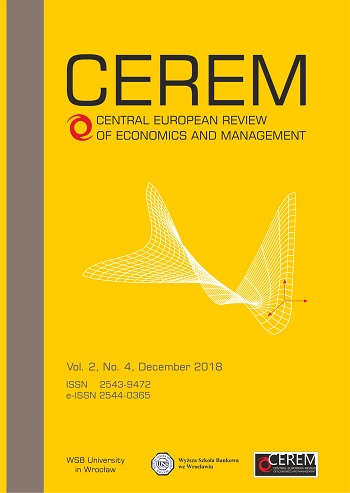The European Neighborhood Policy: a perspective of the partner countries
DOI:
https://doi.org/10.29015/cerem.510Słowa kluczowe:
European Union (EU), European Neighborhood Policy (ENP), Union for the Mediterranean (UfM), Eastern Partnership (EaP), Deep and Comprehensive Free Trade Area (DCFTA), European integration,Abstrakt
Aim: The aim of the paper is an analysis and assessment of the partner-countries’ various positions and interests with regard to the European Neighborhood Policy (ENP). The focus was put on expectations and reservations related to ENP in the partner countries.
Design/ research method: The analysis is based on the subject literature related to the ENP. The paper comprises three parts. The first one depicts general geopolitical overview of the ENP. Second part concentrates on partner countries different approaches towards the initiative and the third section is an attempt to examine the neighboring countries’ conflicting visions towards the ENP.
Conclusions: The widespread criticism of the outcomes of the ENP is a result of grave geopolitical turbulences, i.e.: the Mediterranean partners have experienced the Arab Spring uprisings and the Eastern neighbors have again found themselves in the orbit of particular interests of Russia. The partner countries’ visions and expectations towards the ENP are very diverse. Some of them seek to achieve economic benefits without closer political relations with the EU, others strive to achieve membership in the EU which is perceived as an inherent element of the process of successful reforms and systemic transformation.
Value of the article: The paper addresses the problem of declining the ENP. The reason is twofold: contradictory interests of the partner countries and second, floppy engagement of the UE’s institutions in forging of the ENP policy.
Limitations of the research: The analysis is limited to general political tendencies and line of actions addressed by the ENP partner countries. It resulted both from changes in the ENP agenda as well as international relations and internal turbulences in the regions.
Bibliografia
Bendick A., (2008) The ENP. Visibility and Persepction in the Partner Countries, „Working Paper”, Research Unit EU External Relations, Stiftung Wissenschaft und Politik, German Institute for International and Security Affairs, p. 4.
Boumghar L. (2013), The Algierian position on the European Neighborhood Policy, “Geographical Overview” Institut National d’Études de StratégieGlobale (INESG), Algiers, IEMed Mediterranean Yearbook, pp. 1-3. http://www.iemed.org/observatori-en/arees-danalisi/arxius-adjunts/anuari/iemed-2013/Boumghar%20Algeria%20ENP%20EN.pdf [24.03.2017]
Delcour L. (2011), Bringing South Caucasus Closer to Europe - Achievements and Challenges in ENP Implementation, Natolin Research Papers, no 03, p. 11.
Gromadzki G., (2015), Eastern Partnership Revisited. Associated Countries in Focus, Stefan Batory Foundation, Friedrich Ebert Stiftung, Warsaw, pp. 12-13 http://www.batory.org.pl/upload/files/Programy%20operacyjne/Otwarta%20Europa/Eastern_Partnership_Revisited.pdf [28.03.2017]
Hett F., Kikić s., Meuser S., (eds) (2015), Reassessing the European Neighborhood Policy. The Eastern Dimension, Friedrich Ebert Stiftung, p. 3 http://library.fes.de/pdf-files/id-moe/11483.pdf [24.03.2017]
Koeth W. (2014), The ‘Deep and Comprehensive Free Trade Agreements’: an Appropriate Response by the EU to the Challenges in its Neighborhood? European Institute of Public Administration, , http://www.eipa.eu/files/repository/eipascope/20141120085243_EIPASCOPE_2014_WKO.pdf [22.032017]
Lehne S., (2014), Time to Reset the European Neighborhood Policy, Carnegie Europe, pp. 6-7;
Lorca A., Escribano G. (2015), The Euro-Mediterranean Free Trade Area: From Competition to Integration, p. 9. http://unpan1.un.org/intradoc/groups/public/documents/CAFRAD/UNPAN013747.pdf [24.03.2017]
Prodi R., (2002), “A Wider Europe - A Proximity Policy as the key to stability”, Brussels, 5-6 December 2002, http://europa.eu/rapid/press-release_SPEECH-02-619_en.htm [22.03.2017];
Sadowski R., (2013), Partnership in times of crisis. Challenges for the Eastern European Countries’ Integration with Europe, Centre for Eastern Studies, Warszawa, pp. 9, 28-32
Sarto R. A., Schumacher T. (2005), From EMP to ENP: What’s at stake with the European Neighbourhood Policy towards the Southern Mediterranean? , “European Foreign Affairs Review” no 10 (1) pp. 17-18; 25-28;
Wouters J., Duquet S., (2013), The Arab uprisings and the European Union: in search of a comprehensive strategy, “CLEER Working Papers” 2013/3, Arribas F, Pieters G., Takács T. (eds.) CLEER Conference: One year after the Arab Spring, Seville, Spain, 10-11 May 2012, pp. 22, 37
Youngs R., (2014), Europe in the New Middle East. Opportunity or Exclusion? , Oxford University Press, Oxford, pp. 89-100,
Pobrania
Opublikowane
Numer
Dział
Licencja
Autor przenosi nieodpłatnie na Wyższą Szkołę Bankową we Wrocławiu , bez ograniczeń terytorialnych, majątkowe prawa autorskie do tego utworu w rozumieniu ustawy z dnia 4 lutego 1994 roku o prawie autorskim i prawach pokrewnych ( Dz.U. 1994, Nr 24, poz. 83 ze zm. )na zasadzie wyłączności, tj. prawo do:
a) wyłącznego używania i wykorzystania utworu w dowolnej działalności przez Wyższą Szkołę Bankową we Wrocławiu, w szczególności w działalność Biblioteki Cyfrowej uruchomionej przez Wyższą Szkołę Bankową we Wrocławiu
b) wytwarzania, utrwalania i zwielokrotniania egzemplarzy utworów wszelkimi technikami, w tym techniką drukarską, reprograficzną, zapisu magnetycznego oraz techniką cyfrową, w szczególności ich zwielokrotniania poprzez dokonywanie zapisów na płytach typu CD,
c) zamieszczenia wybranych fragmentów utworu w celach promocyjnych w publikacjach, materiałach promocyjnych, w sieci Internet oraz sieciach wewnętrznych typu Intranet Wyższej Szkoły Bankowej we Wrocławiu,
d) wprowadzania utworu do pamięci komputera Wyższej Szkoły Bankowej we Wrocławiu,
e) kopiowania i powielania utworu w technologiach fotomechanicznych lub innych znanych w dniu zawarcia umowy (fotokopie, kserokopie itp.),
f) przetworzenia dzieła na formę elektroniczną i nieograniczonego rozpowszechniania w sieci Internet.


